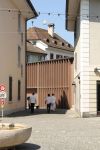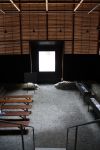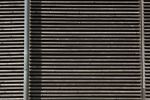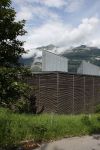Switzerland has an age-old relationship with wood as a construction material. Timber barns dot every emerald-green pastured slope, regardless of the dominant regional culture. These barns, often erected on stone foundations, have stood for hundreds of years. Simple in construction and simple in function, Swiss barns utilize building materials in an efficient and practical way. Their walls are comprised of stacked logs, pairs of parallel timbers with a 90 degree alternating orientation. The result is a maximized utilization of wood, protecting a great area from most of the elements (though the gaps in the construction permit external temperatures, winds, and some precipitation). These barns hold livestock feed for much of the year, and can shelter animals during the severe Swiss winters when they are brought in from their grazing pastures. However, upon my observation, many seem to be empty – at least during the summer season.
So, the Swiss developed an archetype for the application of wood to house voids. Some modern structures are reminiscent of these common barns, though their function is notably different. Two projects with marked similarities and delightfully subtle differences recall the agricultural construction traditions of their homeland while achieving a quiet sacredness that transcends the murky dimness of the barns from which they evolved.
Miller and Maranta’s Market Hall in Aarau is a peaceful, chapel-like place of respite when it is not in use. Presumably, when the Aarau Market is in session, the structure is flooded with vendors and resonating with the tune of Swiss German crowds. On the day of my visit, I was lucky to get inside. Normally locked, the hall was left empty and open for a brief period of the day while its janitors enjoyed the traditionally long Swiss lunch break.
The building is strictly wood. The tight repetition of vertical boards comprises the walls of the structure. Light and air seep calmly through the dark-stained wood fins, spaced about one foot apart. Wood sheathing, a protective measure and shear application, runs the perimeter of the interior walls to a height of approximately 2.5 meters. A single massive column in the center of the structure supports loads too great to be withstood solely by the structural walls. The footprint of the building takes the shape of a rectangle that was bent at its center, leaving an awkward six-sided form that nestles into the crooked streets of old-town Aarau. The single central column breaks the shape into quadrants, defined by the larger structural glue-lams running from the mid-points of the market’s walls. Perhaps to offset the perceived weight of the structure’s heavy wooden members, the connection to the ground is detailed so as to foster an illusion that the hall is floating. Light seeps under the edge of the interior sheathing, and the vertical fins of the walls are connected to the concrete foundation through smaller wood shims. The affect is a perceived gentle connection to the market’s floor.
Though the structurally is arguably rooted in the vernacular of Switzerland’s barns, it is an intriguing collision into its context. Surrounded by the common, 16th century, thick-walled homes that line the narrow streets of many Swiss old-towns, the consistency of the market’s walls are a curious juxtaposition. Loosing any semblance of a traditional pitched roof and free from the restricted apertures of its neighbors, the structure reads as a homogeneous orthogonal mass. Oddly enough, its atmosphere is more that of a temple than a market hall, boasting a rigid replication perhaps reminiscent of the Athenian Parthenon. The quaintness of the Swiss barn is curiously replaced with a degree of reverence despite a similar application of the same building material, and a comparably modest function.
This meditative atmosphere is even more present at Peter Zumthor’s shelters for Roman ruins in Chur. The structures are located on the fringe of the old-town Chur. Consisting of three separate buildings, the museum spaces are connected delicately with footbridges that are reminiscent of bus articulations. Two projected window bays, one per building, are the primary stimulants of curiosity when approaching the site. The rest of the façade consists of canted wooden slats, densely repeated, yet open between and without insulation. The façade system is hung on carefully hidden, metal connections attached to the structure inside. To gain access, one must acquire a key from the city tourism office. The solitude attainable through these strict entry requirements brings the visitor into a profoundly intimate relationship with the building and its contents.
One enters the building through an elevated projected door with a cantilevered step. Throughout the structure, the threshold between the ground and the museum walkways is handled with a great degree of delicacy. You enter onto a suspended catwalk, supported by minimal trusses on either side, and the ground sinks down below you. The excavation pits have the remains of Roman residential foundations, and glass cases that contain a meager display of pot shards and ancient bric-a-brac. In truth, Zumthor’s contributions to the site are far more impressive than the ruins they shelter.
The first volume is the largest, and shares the bent rectilinear form of the Aarau Market Hall. Using a structural grid approximately 8ft by 8ft, this first room is four structural bays by ten, the catwalk traversing the center. The wooden columns of the perimeter walls bear the load of a simple grid system of trusses above. Two large square skylights cut through the center of the truss system, providing a silky wash of light onto the ruins. The second room follows the structural logic, but is half as large. The third room is a mere sliver of a volume; a triangular oddity that seems to frantically embrace some portion of the ruins perhaps not discovered until construction on the shelters began. The two bay windows acquire a fantastic new role on the inside of the shelters. The black fabric panels that line the lower fifth of the museum walls surround the windows with an impenetrable darkness. The result is an extraordinary disconnect from the view outside, both physically and perceptually. Standing on the ground of the excavation pits, one has lost familiar orientation with the now-elevated street outside. The sounds of Chur are still audible, drifting through the open slats of the walls, but the visual connection is now startlingly framed in blackness. The effect is that of watching a television in the dark, with the outside world becoming something distant and peculiar. This only increases the sense of intimacy and reverence within the shelters.
Perhaps the most delightful observation is gleaned after close scrutiny of the structural assembly. Yes, Zumthor uses wooden pegs and traditional wood joinery methods for the majority of the connections. Only the metal cross bracing and the façade screens require industrial fasteners, and a significant amount of care seems to have gone into their concealment.
Remarkably, the Market Hall in Aarau and the Shelters in Chur, when qualitatively analyzed, appear to be mere evolutions of the Swiss agricultural vernacular. They carry on the long tradition of the predominantly empty wooden rooms that dot the landscape, yet their differences are enough to embed them with a near-sacred serenity.
Filed under: Uncategorized



















